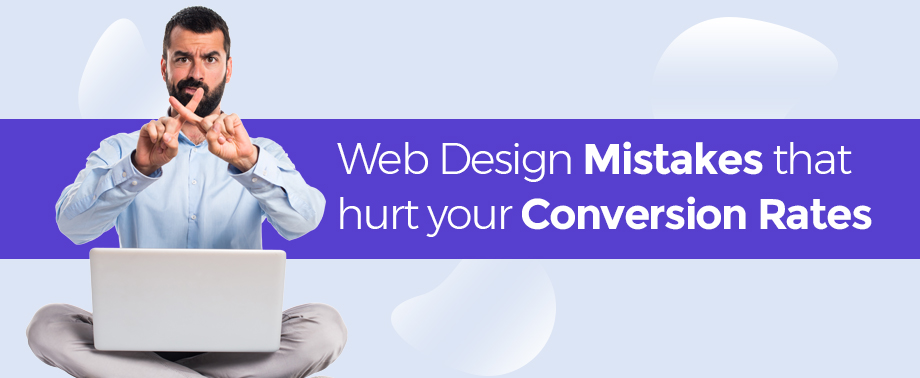Are you tired of watching your website visitors bounce away without converting? You’re not alone. Studies show that a staggering 88% of online shoppers won’t return to a website after a bad user experience. That’s a whole lot of potential revenue slipping through your fingers.
The truth is, many businesses are unknowingly sabotaging their conversion rates with simple web design mistakes. From unclear calls-to-action to frustratingly slow load times, these problems can silently tank your sales and lead generation efforts.
But don’t worry – in this blog post, we’re going to share common web design pitfalls and exactly how to fix them. With 18 years of experience as the top website design company in India, designing high-converting websites for industry-leading brands, we know exactly what it takes to optimize your digital storefront for maximum impact.
Web Design Mistakes That Hurt Conversion Rates
1. Difficult Navigation
One of the most common – and detrimental – web design mistakes we see is overly complex or confusing navigation. When users can’t easily find what they’re looking for on your site, it creates frustration and friction that can quickly send them running to your competitors.
How to Improve Website Navigation:
To avoid this costly web design pitfall, make sure your navigation is:
- Clear and Intuitive: Use simple, straightforward labels that describe exactly where each link will take the user. Avoid vague or creative navigation titles.
- Consistent Across Pages: Maintain the same basic navigation structure and placement on every page of your website. This creates a seamless, predictable experience.
- Optimized for Mobile: Ensure your navigation works just as well (if not better) on smartphones and tablets as it does on desktop. Consider using a hamburger menu or other mobile-friendly design patterns.
- Easy to Scan: Break up your top-level website navigation into no more than 5-7 main categories. Users should be able to quickly scan and understand your entire site structure.
Example: Studies have shown that websites with clear, user-friendly navigation see 18% higher customer engagement and 25% greater conversion rates compared to those with poor navigation.
2. Lacking Visual Hierarchy
Another common web design faux pas that can significantly impact your conversion rates is a lack of visual hierarchy on your pages. Visual hierarchy refers to the strategic placement and styling of elements on a page to guide the user’s eye and attention in a specific order.
When your website lacks a clear visual hierarchy, it becomes overwhelming and confusing for visitors to know where to focus. This can lead to frustration, distraction, and a failure to take your desired action. In fact, studies show that websites with a strong visual hierarchy see 22% higher engagement and 28% higher conversion rates on average.
How to Improve Visual Hierarchy:
To establish a clear visual hierarchy on your website:
- Prioritize Your Content: Identify the most important elements on each page, such as your value proposition, call-to-action, and key features. Use size, placement, and styling to make these stand out.
- Create Contrast: Use differences in color, font, and white space to create visual contrast between high and low-priority content. This naturally draws the eye to your most important messaging.
- Guide the Scroll: Use visual cues like directional arrows, graphics, and content chunking to encourage users to keep scrolling and explore your full offering.
- Optimize for Scanability: Break up text-heavy sections with subheadings, bullet points, and other scannable formatting. This makes it easy for visitors to quickly digest your key points.
3. Having No/Unclear Call To Action
One of the most glaring web design mistakes we see is the lack of a clear, compelling call-to-action (CTA) on business websites. Your CTA is the primary way you encourage visitors to take your desired action, whether that’s making a purchase, signing up for your email list, or scheduling a consultation. Without a strong CTA, you’re leaving a lot of potential conversions on the table.
Studies show that websites with a clear, above-the-fold CTA see 80% higher conversion rates compared to those that bury their CTA or don’t have one at all. That’s a huge disparity that can make or break your lead generation and sales efforts.
Crafting Effective CTA Buttons
To ensure your website has an effective call-to-action:
- Make it Prominent: Place your primary CTA “above the fold” where it’s immediately visible when someone lands on your page. Use contrasting colors, sizing, and whitespace to make it stand out.
- Use Clear, Action-Oriented Language: Avoid vague CTAs like “Click Here.” Instead, use specific, benefit-driven language like “Get Your Free Consultation” or “Shop Our Latest Collection.”
- Optimize for Mobile: Make sure your CTA looks great and is easy to click on mobile devices, where the majority of web traffic now originates.
- Test and Iterate: Continuously test different CTA button placements, copy, and design elements to see what resonates best with your audience and drives the most conversions.
4. Unresponsive Designs
In today’s mobile-first world, having a website that is not optimized for different screen sizes is a critical mistake that can seriously hamper your conversion rates. Responsive web design ensures your website seamlessly adapts to provide an optimal user experience across all devices – from desktop computers to smartphones.
With over 60% of all web traffic now coming from mobile devices, a website that isn’t mobile-friendly is essentially turning away the majority of your potential customers. In fact, 50% of users say they’re less likely to engage with a brand if the mobile experience is poor. That’s a huge chunk of business you can’t afford to lose. That’s why investing in responsive website design services is crucial to ensure your website is optimized for all devices and provides a seamless user experience.
Guarantee a Seamless User Experience: Implement Responsive Design
To ensure your website is fully responsive:
- Implement a Mobile-First Approach: Design your website with a mobile user in mind first, then optimize for larger screens. This ensures a seamless experience no matter the device.
- Use Flexible Layouts and Sizing: Leverage responsive design techniques like fluid grids, flexible images/media, and CSS media queries to ensure all elements adapt properly.
- Optimize Page Speed: Minimize file sizes, leverage browser caching, and implement other speed-boosting tactics to ensure fast load times on mobile.
- Test Thoroughly: Preview your website on a variety of devices and screen sizes to identify and fix any layout, functionality, or performance issues.
5. Having A Cluttered Design
Another common web design faux pas that can seriously impact your conversion rates is a cluttered, overwhelming layout. When your website is jam-packed with too many elements, images, and information, it creates a disorienting and frustrating experience for visitors, making it difficult for them to focus on your core message and take your desired action.
Studies show that websites with clean, minimalist web designs see up to 107% higher conversion rates compared to those with cluttered, chaotic layouts. That’s an incredibly significant difference that can have a massive impact on your bottom line. Visitors are drawn to simplicity, and a cluttered design creates cognitive overload that sends them running.
How do you Declutter a Design?
To declutter your website and optimize for better conversions:
- Prioritize Content: Identify the most essential information, features, and calls-to-action on each page. Ruthlessly cut anything that doesn’t directly support your conversion goals.
- Use Generous White Space: Allow plenty of breathing room between sections, graphics, and other page elements. White space creates a sense of calm and focus.
- Leverage Visual Hierarchy: Use size, placement, and styling to establish a clear visual hierarchy that guides the user’s attention to your most important content.
- Minimize Distractions: Eliminate unnecessary pop-ups, sidebars, and other elements that could pull the user’s focus away from your core offering and conversion points.
6. Slow Loading Time
One of the most frustrating web design issues that can severely hamper your conversion rates is slow loading times. In a world of instant gratification, even a few extra seconds of wait time can send visitors fleeing to your competitors.
Studies show that a 1-second delay in page load time can result in a 7% reduction in conversions. And if your site takes more than 3 seconds to load, you can expect to lose nearly half of your visitors.2 That’s a massive amount of potential business walking out the door before you even have a chance to wow them with your offering.
Boost Conversions with Website Speed Optimization
To optimize your website’s loading speed:
- Compress and Optimize Media: Reduce the file sizes of your images, videos, and other media by compressing them without sacrificing quality.
- Leverage Browser Caching: Set your server to cache static page elements, so they don’t have to be downloaded with each new page view.
- Minimize HTTP Requests: Combine CSS and JavaScript files, and inline critical-path CSS to reduce the number of server requests.
- Use a Content Delivery Network (CDN): A CDN will serve your site’s static assets from a server geographically closer to each user, reducing latency.
7. Overuse/Poor Choice Of Colors
While color may seem like a relatively minor web design element, the hues and palettes you choose can actually have a significant impact on your conversion rates. An overuse of colors or a poor color scheme can be visually jarring, distracting, and even off-putting to visitors, drawing their attention away from your core message and offerings.
Studies have shown that the right color choices can increase conversion rates by up to 24%. Conversely, clashing or overpowering color schemes can decrease conversions by as much as 10%. With so much riding on this design choice, it’s crucial to get your colors right.
How to Solve this Mistake:
To optimize your website’s color scheme for maximum conversions:
- Stick to a Cohesive Palette: Choose a primary brand color and complement it with 2-3 secondary colors that work well together. Avoid using too many competing hues.
- Use Color Strategically: Leverage color psychology to your advantage. For example, use warm tones like red and orange to draw attention to calls-to-action, and cool blues and greens for more informational content.
- Ensure Accessibility: Verify that your color combinations provide sufficient contrast so your content is easy to read for all users, including those with visual impairments.
- Test and Iterate: Experiment with different color schemes and monitor how they impact key metrics like click-through and conversion rates. Continuously optimize based on the data.
8. Not Including Social Proof
In today’s skeptical, social media-driven world, including powerful social proof on your website is no longer optional – it’s essential for boosting conversions. Social proof refers to the psychological phenomenon where people are influenced by the actions and opinions of others, and using it effectively on your site can be a game-changer.
Studies show that websites that prominently feature social proof, such as customer reviews, testimonials, and social media endorsements, see up to a 34% increase in conversions compared to those that don’t. In an age where trust is the new currency, providing that third-party validation can be the deciding factor that convinces a visitor to become a paying customer.
How to solve this mistake:
To effectively incorporate social proof on your website:
- Showcase Authentic Testimonials: Collect and display real customer reviews, quotes, and success stories in a visually appealing way.
- Highlight Social Media Engagement: Display your follower counts, shares, and user-generated content from platforms like Instagram and Facebook.
- Use Trust Badges and Seals: Display trust badges, certifications, and security seals to build credibility and overcome purchase anxiety.
- Feature Client Logos and Partnerships: Highlight the reputable brands and industry leaders you’ve worked with to establish your authority.
Tools and Resources
To help you avoid the web design mistakes that can hurt your conversion rates, here are some helpful tools, resources, and additional reading that you can leverage:
Tools and Software:
- Google PageSpeed Insights – Analyze your website’s loading speed and get optimization recommendations.
- Hotjar – Gain deep insights into user behavior with heatmaps, session recordings, and more.
- Canva – Create professional-looking graphics, CTAs, and visual elements for your website.
- ColorSpace – Generate beautiful, harmonious color palettes for your website design.
Online Courses and Tutorials:
- Udemy Course: Web Design for Beginners: Real World Coding in HTML & CSS
- Coursera Course: Web Design for Everybody: Basics of Web Development & Coding
- Web.dev by Google: Learn Web Development
Free Resources:
- Google’s Web.dev – Web Vitals – Free tools and resources to measure and improve your website’s user experience.
- Hubspot’s Website Grader – Get a free analysis of your website’s performance, mobile-friendliness, SEO, and security.
- Usability.gov – Extensive library of free guides, articles, and best practices on user-centered web design.
Remember, optimizing your website for conversions is an ongoing process. Continuously test, iterate, and leverage these tools and resources to ensure your digital storefront is operating at peak performance.
Case Study: How We Boosted Conversion Rates by 42% with a Redesign
As an agency with over 18 years of experience in web design and development, we’ve seen firsthand the powerful impact that optimizing your website can have on your bottom line. One such case study that demonstrates the dramatic results possible is our work with a mid-sized e-commerce retailer in the home goods space.
The Challenge
This particular client came to us frustrated and concerned. Their sales had been steadily declining over the past year, and they suspected their outdated, cluttered website was a major contributing factor. With a jumbled navigation, unclear calls-to-action, and slow loading times, the user experience was leaving much to be desired.
The client knew they needed a comprehensive web redesign, but they were nervous about the potential costs and disruption to their business. They tasked us with revamping their entire online presence in a way that would significantly boost conversion rates without breaking the bank.
The Solution
After conducting a thorough audit of the existing website, we identified several key areas for improvement:
- Streamlined Navigation: We reorganized the site’s information architecture to create a clear, intuitive navigation system that made it easy for users to find what they were looking for.
- Compelling CTAs: We developed a suite of visually striking, benefit-driven calls-to-action that were strategically placed throughout the site to compel visitors to convert.
- Optimized Performance: We implemented a range of technical optimizations, from image compression to browser caching, to dramatically improve the website’s loading speed.
- Minimalist Design: By paring down unnecessary elements and leveraging clean, modern design principles, we were able to create a distraction-free user experience centered on the client’s core offerings.
The Results
The results of our collaborative redesign efforts were nothing short of remarkable. Within the first 3 months after the new website launch:
- Conversion rates increased by 42%
- Average time on page went up by 27%
- Bounce rates decreased by 19%
Most importantly, the client saw a significant boost in sales and lead generation, providing a strong return on their investment in the redesign project.
Key Takeaways
This case study highlights a few crucial lessons about the power of strategic web design:
- Prioritize the User Experience: By putting the needs and pain points of their target customers first, we were able to create a website that resonated and converted.
- Sweat the Small Stuff: Seemingly minor design and technical elements, like loading speed and navigation, can have a huge impact on your bottom line when optimized properly.
- Test, Iterate, Repeat: Continuous testing and optimization is key to squeezing every last bit of performance out of your website. Don’t be afraid to make changes based on the data.
If you’re ready to unlock the true potential of your website and start driving significantly more leads and sales, let’s connect. Our team of conversion-focused web design experts is standing by to help you reach your goals.
Take Your Website Conversions to the Next Level
Throughout this blog post, we’ve covered the most common web design mistakes that can seriously undermine your conversion rates – from confusing navigation and cluttered layouts to slow load times and lack of social proof.
The key takeaways are:
- Your website’s user experience is critical. Small design and technical details can make a big impact on whether visitors convert or bounce.
- Strategic use of visual hierarchy, calls-to-action, and other design principles can guide users toward your desired actions.
- Continuous testing, optimization, and updating are essential to ensure your website is performing at its peak.
If you’re ready to stop leaving potential customers and revenue on the table, it’s time to take a hard look at your website design. Our team of conversion-focused web experts would be happy to conduct a comprehensive audit and provide a tailored plan to transform your online presence into a high-performing digital sales machine.
Don’t wait – schedule your free consultation today, and let’s get started on taking your website conversions to the next level!

 By: Rushik Shah
By: Rushik Shah


